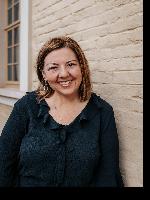
Snapshots are a pairing of two 20 minute presentations followed by a 5 minute Q & A.
This is presentation 2 of 2, scroll down to see more details.
Other presentations in this group:


This presentation will focus exclusively on the implementation of a flexible learning supplement from Tobii Dynavox. Most significantly, the therapeutic interventions that make up the true focus of this presentation can be applied to a wide variety of available tools or products.
Students who are eligible for special education are entitled to all necessary accommodations that allow them access to curriculum and meet their fullest academic potential (Zirkel, 2005). Many districts fulfill this mandate by establishing self-contained classrooms for students in special education from K-12. One critical element that contributes to the efficacy of the of the self-contained classroom is small group learning. Small groups allow for more one-on-one attention, closer relationships between teachers and students, and instruction that closely aligns with individual education goals (Logan & Keefe, 1997). Further, self-contained classrooms can provide a context for significant academic learning gains (McGrath & Rust, 2002). Despite these benefits, challenges remain, particularly as they relate to both curriculum and instruction.
One of the most significant challenges for teachers and other related service professionals is accessing meaningful curriculum. For one, it is unclear who is responsible for providing it. Often enough, teachers wait for materials that are designated at a district level while administrators are waiting to hear what special educators want and need. Additionally, few adapted curricular programs are consistent with the expectations for real academic growth that are inherent to today's educational standards (Common Core Standards, 2010) nor are they precisely differentiated to meet the range of learning levels within an individual classroom. Many teachers choose to create their own curriculum and adapt it, but this effort requires both time and creativity. Finally, many students, including those with disabilities may have complex or even idiosyncratic methods for accessing curriculum. This requires teachers have deep knowledge, use, and implementation know-how of the various supports, AAC solutions, and assistive technology available today.
Given these challenges, today's teachers would benefit from a curriculum or program that was ready-made (to save time), aligned to today's standards (to ensure that it is academic in nature) and easily adapted to be accessible to students with a wide range of access needs. Ideally, this curriculum would also be leveled to meet learners at different learning levels while also being thematic in nature, so that students could at different levels could still form learning communities. Ideally, since many special education classrooms already place emphasis on word learning to support literacy development, the curriculum would support students in developing background knowledge. This kind of knowledge development is often overlooked and not only supports students in their literacy development but also gives them opportunities to engage in learning across the content areas, like science and social studies (Researcher, date).
In this session, the presenter swill outline the challenges and opportunities that are inherent in providing instruction to students with a range of learning needs in self-contained classrooms. They will discuss the gains students made in engaging with academic learning, the methods they deploy to enhance this engagement from both children and adults, as well as the challenges that she continues to face in supporting all students in accessing the meaningful, evidence-based curriculum.
Our goal for this presentation is to review and share an easy-to-use curriculum-driven activity framework that clinicians and educators can offer students of all levels, as a means to connect them to their academic standards while still meeting their cognitive and communicative needs.
1. Introductions and Explanations (5 minutes)
2. Changing Education Context Post-Pandemic (10 minutes)
3. Reflection on Adapted Curriculum: Challenges and Opportunities (15 minutes)
4. Four Evidence-based Shifts in language/literacy curriculum (15 minutes)
5. Demonstration of accessible platforms and free resources (10 minutes)
Questions and Comments (5 minutes)
References:
Alwell, M., & Cobb, B. (2009). Functional life skills curricular interventions for youth with disabilities: A systematic review. Career Development for Exceptional Individuals, 32(2), 82-93.
Binger, C., & Light, J. (2007). The effect of aided AAC modeling on the expression of multi-symbol messages by preschoolers who use AAC. Augmentative and Alternative Communication, 23(1), 30-43.
Buchnat, M., & Wojciechowska, A. (2020). Online education of students with mild intellectual disability and autism spectrum disorder during the COVID-19 pandemic. Interdisciplinary Context of Special Pedagogy, 29(1), 149-171.
Castelli, C. (2016). Balanced Literacy Instruction for Students with Significant Cognitive Disabilities: Barriers to Implementation (Doctoral dissertation, McKendree University).
Common Core State Standards. National Governors Association. (2010). Common core state standards. Washington, DC.
Erickson, K. A., Clendon, S., Abraham, L., Roy, V., & Van de Carr, H. (2005). Toward Positive Literacy Outcomes for Students with Significant Developmental Disabilities. Assistive Technology Outcomes and Benefits, 2(1), 45-54.
Hogan, K. E., & Pressley, M. E. (1997). Scaffolding student learning: Instructional approaches and issues. Brookline Books.
Jackson, L. B., Ryndak, D. L., & Wehmeyer, M. L. (2008). The dynamic relationship between context, curriculum, and student learning: A case for inclusive education as a research-based practice. Research and Practice for Persons with Severe Disabilities, 34(1), 175-195.
Domingue, B. W., Hough, H. J., Lang, D., & Yeatman, J. (2021). Changing Patterns of Growth in Oral Reading Fluency During the COVID-19 Pandemic.
Rose, D. H., Meyer, A., & Hitchcock, C. (2005). The universally designed classroom: Accessible curriculum and digital technologies. Harvard Education Press. 8 Story Street First Floor, Cambridge, MA 02138.
Seligmann, T. J. (2001). An IDEA schools can use: Lessons from special education legislation. Fordham Urb. LJ, 29, 759.
Yoder, D. (2001). Having my say. Augmentative and alternative communication, 17(1), 2-10.